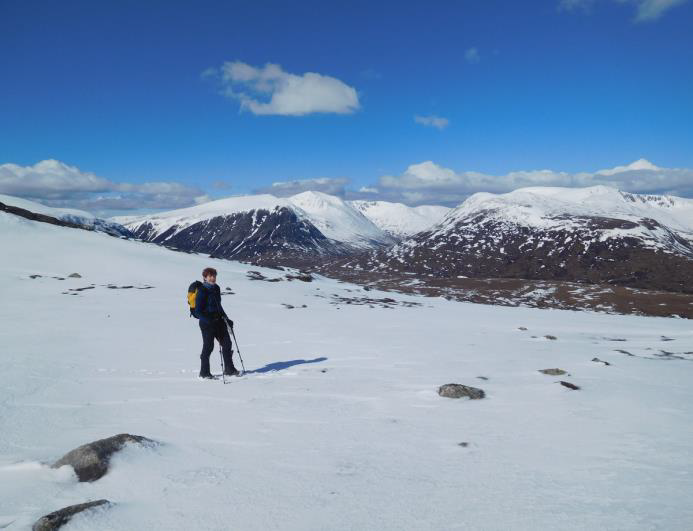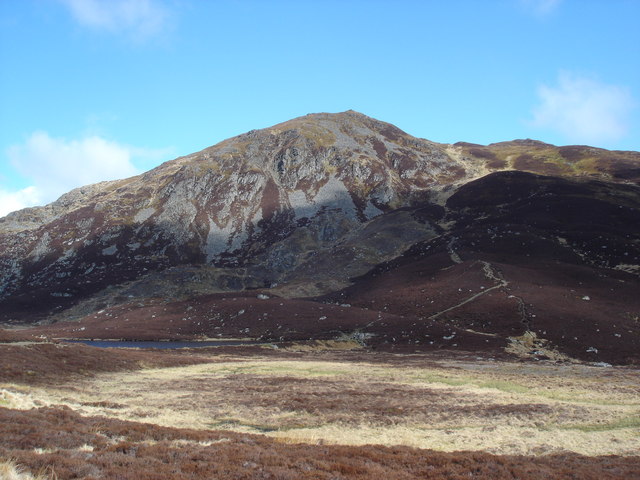
Sub Editor with view of Cairngorms from Carn na
Drochaide
Compleating (after Izaak Walton, The Compleat Angler, 1653) the Scottish Corbetts seems a suitable opportunity to reflect on these hills, particularly those on the North-East where my efforts started off. Some may be rather “popular” and others are best labelled “unpretentious”, but several have a character of their own, and lie in areas uninfested by Munros, and so offer new realms for pedestrian exploration.
Definitions first: not easy, with neither the Cairngorms nor the North-East well defined, and various guides using different systems, but let us take the A9 as the frontier. The SMC Corbetts Guide has 13 Corbetts in “The Cairngorms and Buchan”, the latter to include Corryhabbie Hill and Ben Rinnes. To the east of the main Cairngorms there are Carn Mor and Carn Ealasaid on the Lecht, Brown Cow Hill, and Morven. That leaves 7 Corbetts as satellites to the main Cairngorms, most giving fine views of the core: Culardoch, Carn Liath and Carn na Drochaide on Invercauld, Sgor Mor above White Bridge, Creag Mhor hiding behind Bynack More, Geal Charn above Dorback Lodge, and Meall a’ Buchaille above Glenmore Lodge. South and east of Braemar, Corbetts are rather scarce: only Creag nan Gabhar between Glens Clunie and Callater, Monamenach above Glen Shee, Conachcraig east of Lochnagar, Ben Tirran above Glen Clova and Mount Battock away to the east. Southwest of Braemar, there are several more: six between Glens Feshie and Tromie, i.e. Beinn Mheadhonach above Glen Tilt, Bens Vrackie and Vuirich north of Pitlochry, and Morrone and Ben Gulabin west of the road to Blairgowrie. And still further southwest, we have Meallach Mor, Carn Dearg Mor and Leathad an Taobhain south of Glen Feshie, and Craig an Loch and An Dun straddling the Gaick. Most of these hills defend themselves at a lower level by deep heather, through which bulldozed hill tracks, however objectionable in visual terms, offer welcome routes, deer having a distressing tendency to avoid useful uphill direction, whether direct or zigzag. But higher up, the vegetation relents, and many NE Corbetts have fine rocky outcrops near their summits.
Sgor Mor above the Linn of Dee provides a fine broad ridge walk on a splendid surface: the problem is getting up there! The hike out on the track to White Bridge is perhaps the usual route, getting the distance behind you at the start of the day, and with luck the wind behind you as you ascend from beyond the Chest of Dee. The ascent direct from the Linn of Dee is not to be recommended, unless a path has been worn by human or cervine feet along the fence put up some years ago to keep the deer away from the tree regeneration around Derry Lodge. My favourite ascent route is to go up the Lui’s southwest bank for about 1 km beyond the Black Bridge, and then follow the burn between the plantations on firm ground to the moor, to reach the ridge (and fence) via the Caochan Bheithe (1:25000 OS map only). From there, one can head north to the trig point (and old radio aerial, lying on the ground) on Sgor Dubh above Derry Lodge, or contour west to the main ridge to approach the rocky summit, with its fine pothole. The route, with or without the summit, also makes a pleasingly different way to or from Corrour, with only a short bit of bog near the Carn a’Mhaim path.
 |
|
Sub Editor with view of Cairngorms from Carn na
Drochaide |
Carn na Drochaide is another fine viewpoint, this time of Ben a’Bhuird and Avon, though not the best side of the latter Munro. The hill is approachable either from the Quoich, by the direct path up the Allt na h-Earba, or via Carns Elrig Beag and Mor, where some rather ugly hill tracks are now recovering from bulldozer “repairs” after Storm Frank wash-outs in 2015. An alternative approach is to cross a short bit of bog from the head of Glen Slugain (where Ciach Lodge stood, before its now-ruined successor was built a little further down the glen) to gain Carn na Criche, where there is a fine curved shelter (another four-way effort is to the west of Ben a Bhuird’s An Diollaid path). Past a dried-out lochan, the main Carn na Drochaide summit is festooned with cairns, The southern flank of the hill, with fine views down to Braemar and its Castle, carries a fringe of old Scots pine, left after wartime fellings. Where the bridge implicit in the hill name was located appears unknown – probably not over the Dee, but perhaps over the Slugain near Invercauld?
 |
|
Ben Vrackie ©Andy Waddington CC BY-SA 2.0 |
Ben Vrackie is the most southerly of the “NE” Corbetts, and an obvious target from Pitlochry, or even better from the Moulin Inn . The tourist path from here is a straightforward uphill walk, covering a mixture of woodland, moor, loch, and lava-on-schist at the top – which is well sprinkled with funereal ash from the frequent scatterings carried out up here! An indicator explains the splendid all-round view, and there is a memorial to a dragoon killed in 1947 in Palestine. A group of us once extended an ascent by heading north-east from here over knobbly knolls to beyond Creag Spardain, from where a newish track led northwest to semi-abandoned Shinagag (once with gas, bath, etc.) now in occasional use for sheep shearing. From here, across much grass, we contoured southwest above Glen Girnaig to the track above Coppagach, one of many ruins in this limestoney glen, said to be a likely site for Geyer’s Whorl Snail, Vertigo geyeri (not many people know that!), in order to round the Ben back to the tourist path. Further down the glen, below Loinmarstaig, the gorge has a hidden water works and a fine wee waterfall. An alternative ascent route starts from the NTS Killiecrankie centre, from where the signposted Bealach Path zigzags efficiently up until one can ascend the NW ridge, or carry on to join the tourist path. Ascents of the Ben from the A924 to the east of the hill, over miles of pathless moor, and/or through solid plantation, look dire!
Of course, what with guides, lists and websites, Corbetts, like bothies, are not the relatively unscathed objectives they used to be, and paths and even way-cairns are now appearing on even the more remote ones in Scotland. And the tourism industry has clocked on: see for example https://www.visitabdn.com/blog/corbetts/. So I feel less bad about this bit of Corbett publicity than I might have done a couple of decades ago!
Please let the webmaster know if there are problems with viewing these pages or with the links they contain.